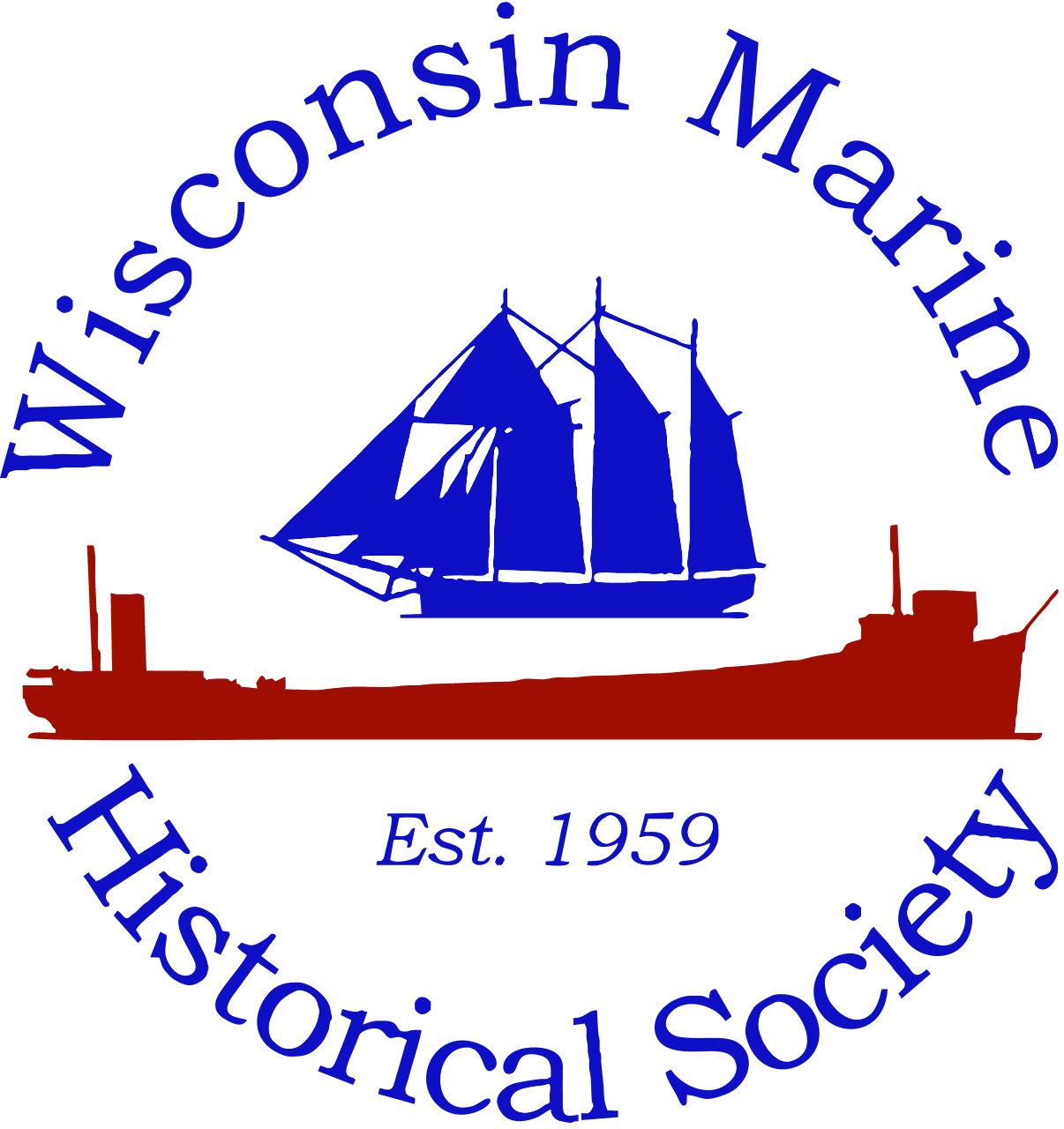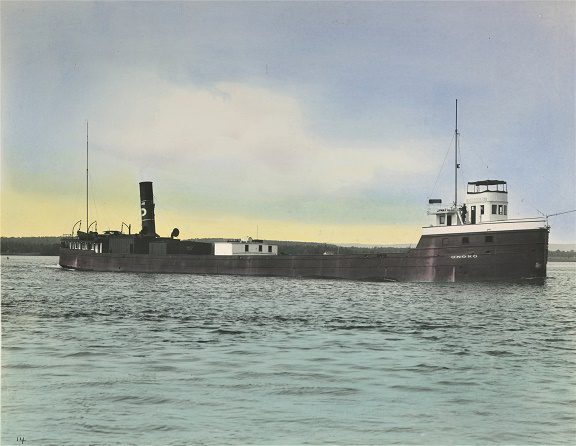By James Heinz
(Steinbrenner Story Chapter Three)
The evolution of the classic Great Lakes bulk carrier, with its forward pilot house, rear cabins, galley, and engine room, and unobstructed midsection or spar deck for loading and unloading cargo is generally traced to the R. J. HACKETT, launched in 1870. She was only 225 feet long and was made of wood.

The failure of the WESTERN RESERVE was due to her steel construction, which Peter Minch had pioneered. However, she was not the first metal hulled ship on the Lakes. Someone had to launch the first classic Great Lakes bulk cargo carrier built of metal, and that person was Peter Minch’s father, Philip J. Minch I. The vessel was called the ONOKO.
ONOKO was launched in 1882 at Cleveland, Ohio. She was 2,164 gross tons, 287 feet long, and 39 feet wide. She was not made of steel but rather of iron. She was the first iron or metal hulled ship built on the Great Lakes.
And we know this because George Steinbrenner himself told us.
Note: the story of the Minch and Steinbrenner families is confusing because of their habit of re-using names. There are two Philip Jacob Minches, a total of three Philip Minches, two Anna Minches, three Henry George Steinbrenners, and four George Michael Steinbrenners.
The Steinbrenner that we are referring to was George Michael Steinbrenner III. Unless otherwise noted, he is the one we are referring to. As his life went on, our George III would drop his middle name.
It is appropriate that our George was George III since his subordinates would come to regard him in much the same way that American patriots would come to regard their George III.
The Minch and Steinbrenner families would carry over into their ships their tradition of using the same name multiple times. In terms of ships, there were two GEORGE M. STEINBRENNER ships, four HENRY STEINBRENNER ships, two KINSMAN ENTERPRISE ships, and two PHILIP MINCH ships

In the WMHS files there is a record of an interview with George Steinbrenner III, who tells the interviewer that he is writing a history of his family’s shipping line, of which he was then the current vice-president, a project which seems never to have been completed.
George III explained that his grandfather Philip Jacob Minch I was the man who came up with the idea of an all metal bulk carrier. In another talk George III gave to the Lake Carriers Association in 1967, he referred to his grandfather, the father of Peter Minch, as “nutty Phil.” The word nutty, among others, would come to refer to George himself in future years.
Philip Jacob Minch I (1820-1887) was born in Germany. In much the same way as two bicycle mechanics would invent the airplane, Philip I was a shoemaker who invented the metal Great Lakes bulk carrier. He came to Vermillion, Ohio, in 1840 where he practiced his trade before moving into the dry goods business.
George III described his great great grandfather as “a failure in many things, but a successful sailor and ship owner when he found sailing was his calling.” Peter Jacob Minch I married Anna Christine Leimbach Minch I (1818-1905), who gave birth to Peter G. Minch (1842-1892) and Sophia F. Minch (1854-1933).
Maritimehistoryofthegreatlakes.ca tells us that starting in 1848 Philip Minch I built eight wooden schooners at Vermilion, Ohio, one of which he named for his daughter Sophia Minch. The first was a wooden scow schooner called the LINDEN. Exhibiting a desire to keep costs down that would mark later generations of his family, he would walk 40 miles to Cleveland to book cargos for his ships at Vermillion, and then walk 40 miles back home.

He moved to Cleveland in 1875 and founded the Minch Transit Company and the Nicholas Transit Company shipping firms. He was one of the founders of the Cleveland Shipbuilding Company, which constructed the WESTERN RESERVE.
Cleveland Shipbuilding of Cleveland would become American Shipbuilding Company of Lorain.
After the death of Philip J. Minch I, his son Peter would have a ship named for his father built at the Cleveland Shipbuilding Company. The ship PHILIP MINCH was built in 1888 and was a reversion to the wooden bulk carriers that came before the ONOKO. She displaced 1888 tons, was 275 feet long, and 41 feet wide. It had four masts and three sets of sails.
On the night of November 19-20, 1904, the PHILIP MINCH I was sailing across Lake Erie when she caught fire in the stern, just like the ROGER BLOUGH. The cause of the flames was never determined and they were not detected until the fire had spread. The crew fought the fire for two hours until the captain ordered the ship abandoned in such a hurry the crew escaped in only the clothes they were wearing.
A ship burning in the night can be seen some distance away, and 12 miles away the Marblehead Lifesaving Station saw her. They launched their surfboat and rowed out to the burning ship. On the way out, they passed the crew of the MINCH in the dark rowing back to shore. The Lifesavers found no one to rescue.
Normally wooden ships burn to the waterline, but the MINCH apparently sank before much of her upper works were consumed by the flames. She was apparently considered to be a hazard to navigation and the wreck was dynamited in 1906. However, divers who have visited the wreck report that it seems more intact than a dynamited ship should be, and reported that her triple expansion steam engine rose thirty feet off the bottom. The attempt to remove her as hazard to navigation was unsuccessful since in 1996 a modern ore freighter hit the engine and knocked it over.
George III went on to tell his interviewer that due to her metal construction, his great-grandfather’s ONOKO could carry 3,000 tons of iron ore when most ships of the day could only carry 300 tons. In cargo ships size does matter, since the crew size remains the same regardless of how large the ship is.

In much the same way that farmers told Henry Ford to “get a horse”, many commentators expressed skepticism that the ONOKO would work out, suggesting she be called the “White Elephant.” In addition to skepticism about her metal construction, she was found by critics to be aesthetically unpleasing, being described as “homely, and “an eyesore.”
When Peter Minch launched the steel hulled WESTERN RESERVE, many said the same thing. Although the skeptics proved right in the case of the WESTERN RESERVE, they were wrong in the case of the ONOKO. She sailed for 33 years. She proved the concept of metal ship construction by setting and breaking new records for amounts of cargo hauled.
George Steinbrenner III himself described the sinking of his great-grandfather’s innovation. In September 1915, the ONOKO struck bottom while departing a grain elevator in Duluth, Minn. She was inspected and determined to be seaworthy.
On September 15, 1915, ONOKO departed Duluth again with 110,000 bushels of wheat. At 12:20 pm, when she was off Knife Island, about 15 miles from Duluth, an oiler appeared on deck shouting, “She’s sinking, she’s sinking!” It was a beautiful clear day with calm seas, and Captain William Dunn at first thought that the oiler was wrong.
However, as he entered the stern cabin he heard the sound of gushing water splashing off the engine cylinders. Engineer J. J. Higgins told Capt. Dunn that water suddenly began coming up through the floor plates under the engine. The water rose rapidly and put out the boiler fires, and Engineer Higgins found himself waist deep in water. The leak could not be stopped and the pumps could not handle the inflow. The engine room crew evacuated the engine room.
Capt. Dunn returned to the bridge and ordered Abandoned Ship. The crew at first thought that the order was a joke, and went to the lifeboats laughing, except for the cook, who ran so fast to the lifeboats that his chef’s hat flew off.
The crew got into the lifeboats and rowed about 300 feet away. They then watched ONOKO slowly sink stern first. The stern slipped silently under the water and then the bow rose 150 feet out of the water. Water rushing into the hold from the stern surged forward, compressing air in the ship and shoving it forward. As the compressed air exited the elevated bow, it blew the pilot house into bits of wood.
Then, in the words of one of the crew, “She just quivered there and then she just slid right down, just as softly and quiet like, you never even knowed she was there;” except for the debris the ONOKO left floating on the surface, which included terrified rats trying to climb on any floating object. The ONOKO took ten minutes to sink.
One of the crew took a remarkable series of photos showing the ONOKO going down. The crew was picked up by the Standard Oil tanker RENOWN and returned to Duluth.
On April 10, 1988, shipwreck divers Jerry Eliason and Kraig Smith found the ONOKO in 220 feet of water. They had to make over 800 passes in a Zodiac boat before the observed the distinctive profile of a shipwreck on their depth finder.
When they arrived on the bottom, they found the ONOKO upside down on the bottom. They positively identified the ship by a distinctive mushroom anchor she was carrying, which appeared on a photo of the ship taken shortly before she sank.
Wikipedia states: “Her wreck rests upside down in 220 feet of water with her stern buried almost completely in mud. Her hull is broken nearly in two, with the split in her hull right in front of her boilers. Her wreck is surrounded by many artifacts from inside and outside her hull.”
WMHS files state: “A portion of the pilot house is near the bow, a bell mouthed ventilator lies near the stern. Several sinks and much other debris have been found around the stern. Only a few skin plates connect the two pieces (of the hull). Most of the wooden parts have rotted away.” They did not find any evidence of the damage to the bottom that supposedly caused the leak.
NEXT: SOPHIA MINCH AND THE WRECK OF THE SOPHIA MINCH
Photo at the top of page: ONOKO in a colorized photo.
Photo Credit: Great Lakes Marine Collection of the Milwaukee Public Library and Wisconsin Marine Historical Society.
____________________________________
James Heinz is the Wisconsin Marine Historical Society’s acquisitions director. He became interested in maritime history as a kid watching Jacques Cousteau’s adventures on TV. He was a Great Lakes wreck diver until three episodes of the bends forced him to retire from diving. He was a University of Wisconsin – Milwaukee police officer for thirty years. He regularly flies either a Cessna 152 or 172.
GEORGE STEINBRENNER, GREAT LAKES SHIP OWNER – Chapter One
THE WRECK OF THE WESTERN RESERVE – Chapter Two
NUTTY PHIL AND THE WRECK OF THE ONOKO – Chapter Three
SOPHIA MINCH AND THE WRECK OF THE SOPHIA MINCH – Chapter Four
HENRY STEINBRENNER I, GORDON LIGHTFOOT, AND THE WRECK OF THE HENRY STEINBRENNER I – Chapter Five
THE WRECK OF THE ANNA C. MINCH – Chapter Six
HENRY STEINBRENNER II AND THE SHIPWRECK THAT BECAME A SHIP AGAIN – Chapter Seven
AN OLDIE BUT A GOLDIE: HENRY STEINBRENNER II AND THE J. B. FORD – Chapter Eight
HENRY III AND GEORGE STEINBRENNER III: LIKE FATHER LIKE SON – Chapter Nine
KINSMAN TRANSIT IS IN TROUBLE – Chapter Ten
GEORGE III SAVES KINSMAN TRANSIT – Chapter Eleven
GEORGE III SAVES AMERICAN SHIPBUILDING – Chapter Twelve

